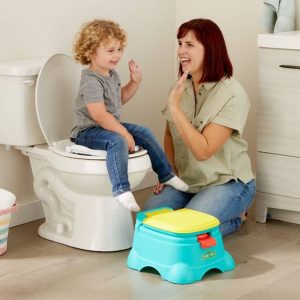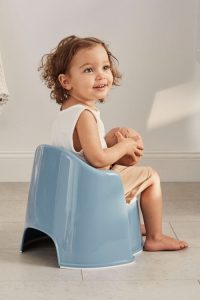Potty training is a big milestone for both toddlers and parents. It can feel overwhelming, but with the right approach, it can be a positive and empowering experience for everyone. The Guide to Success Potty Training. This guide will equip you with the knowledge and strategies to help your toddler succeed in potty training.
Signs of Potty Training Readiness
Every toddler develops at their own pace. Here are some signs that your toddler might be ready to start potty training:
Shows interest in the toilet:
Your toddler may be curious about the toilet and how you use it.
Stays dry for longer stretches:
This indicates better bladder control.
Can pull down and pull up pants:
Independence with dressing is a helpful skill for potty training.
Seems bothered by dirty diapers:
Toddlers who show discomfort in wet or soiled diapers may be ready for potty training.
Getting Prepared for Potty Training
Before you embark on the potty training journey, here are some steps to get prepared:
- Gather supplies: You’ll need a potty chair sized appropriately for your toddler, comfortable underwear (pull-ups can be helpful during transitions), and easy-to-clean clothes for potential accidents.
- Talk to your toddler: Introduce the concept of using the potty in a positive way. Read books about potty training together and let your toddler see you using the toilet.
- Choose a potty training method: There are different potty training methods available. Research and choose one that feels right for you and your toddler’s temperament.
Here are some popular potty training methods:
- Traditional method: This method involves offering the potty regularly and rewarding successes with praise.
- Quick-start method: This method involves intensive potty training over a short period.
- Elimination Communication (EC): This method involves recognizing your toddler’s cues to eliminate and offering the potty at those times.
Remember: There’s no one-size-fits-all approach. Choose a method that aligns with your parenting style and your toddler’s needs.
Making Potty Training a Positive Experience
Potty training is a learning process. Here are some tips to make it a positive experience for your toddler:
- Be patient and encouraging: Accidents are inevitable. Celebrate successes, no matter how small, and offer gentle guidance during mishaps.
- Create a potty-training routine: Offer the potty at regular intervals, such as after waking up, before bedtime, and after meals.
- Use positive reinforcement: Praise your toddler for using the potty and for their potty training efforts.
- Make it fun and engaging: Let your toddler choose fun underwear or potty stickers. Sing songs or read stories while they sit on the potty.
Troubleshooting Common Potty Training Challenges
Here are some common potty training challenges and solutions:
- Accidents: Accidents are a normal part of potty training. Stay calm, clean up the mess, and offer the potty again.
- Holding it in: Some toddlers may hold their stool because they dislike using the potty. Offer reassurance and a relaxing potty environment.
- Regression: Sometimes toddlers regress after some progress. This is normal. Be patient, consistent, and supportive.
Remember: If you’re concerned about your toddler’s potty training progress, talk to your doctor.
Potty training is a journey, not a race. With patience, consistency, and positive reinforcement, your toddler will succeed at their own pace. Celebrate their achievements and enjoy this special milestone together.
Your doctor is always a valuable resource for questions or concerns you may have about your toddler’s potty training journey.
Nighttime Potty Training: Taking It One Step at a Time
Nighttime potty training can take longer than daytime training. Here are some tips for a smooth transition:
- Wait until your toddler is mostly dry during the day: This indicates better bladder control, which is helpful for nighttime dryness.
- Limit fluids before bedtime: Avoid sugary drinks or large amounts of liquid close to bedtime.
- Nighttime potty routine: Take your toddler to the potty right before bed, and again if they wake up during the night.
- Pull-ups for nighttime: Use pull-ups at night for comfort and absorbency while your toddler transitions to nighttime dryness.
- Praise and encouragement: Celebrate dry nights and offer reassurance if accidents happen.
Potty Training and Your Child’s Development
Potty training is a developmental milestone. Here are some things to keep in mind:
- Every toddler develops at their own pace: Don’t compare your toddler’s progress to others.
- Focus on positive reinforcement: Praise and encouragement are more effective than punishment.
- Be patient and understanding: Accidents are a normal part of the process.
- Trust your instincts: You know your toddler best. Choose a potty training approach that feels right for your family.
Potty Training FAQs
Here are some frequently asked questions about potty training to provide additional information:
-
What if my toddler shows no interest in potty training? Don’t pressure them. Wait a few weeks or months and try again when they seem more receptive.
-
How long will potty training take? It varies! It can take weeks or months for toddlers to become fully potty trained. Be patient.
-
Is it okay to use treats or rewards for potty training? Yes, small rewards can be a positive reinforcement tool. Praise and encouragement are important too.
-
What about screen time during potty training? Limit screen time while potty training. This helps toddlers focus on the task at hand.
-
Should I potty train twins at the same time? Not necessarily. It can be easier to focus on one at a time. But if they’re both showing signs of readiness, you can try training them together.

Additional Potty Training Tips
Here are some additional potty training tips that can help make the process smoother:
- Make it a positive experience: Use positive reinforcement and avoid punishment. Celebrate successes, no matter how small.
- Be patient: Accidents are inevitable. Stay calm, clean up messes, and offer the potty again.
- Consistency is key: Stick to a routine as much as possible. This helps toddlers feel secure and predictable.
- Let your toddler take the lead: When possible, allow your toddler to initiate potty breaks. This fosters independence and a sense of control.
- Boys may take longer for bowel control: This is perfectly normal. Be patient and offer support.
- Relax and have fun!: Potty training can be stressful at times, but try to relax and make it a fun learning experience for both you and your toddler.









